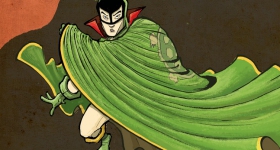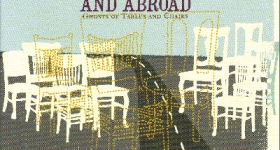Asian Americans are no strangers to comics. Head to
Comic-Con and you’ll see many Asian American fans. But we aren’t just relegated
to the masked and costumed otaku (crazed anime or manga addict) that make up the
ranks of comic book fandom, we are also the creators. Many of the tables and
booths at these conventions are populated by Asian Americans. And while Asian
Americans have a big presence in the mainstream comics industry, there is still
a dearth of main characters that look like us between those pages. The
Alternative Press Expo, Comic-Con’s cooler indie cousin, fares a little better
as the artists who exhibit there are in the independent, alternative, and
self-published comics scene.
But what would it look like if Asian Americans
ruled the comics industry, mainstream or otherwise? Jeff Yang, Parry Shen, Keith Chow, and
Jerry Ma asked themselves that same question. They saw that despite the
prevalence of Asian American writers and artists in the mainstream comics
industry, a void in representation exists. So they produced and edited Secret Identities: The Asian American
Superhero Anthology in 2009 which put Asian faces and stories into the
superhero genre. Their latest book in the Secret
Identities series, Shattered: The
Asian American Comics Anthology, is more ambitious and broader in scope. In
Shattered, the many contributors to
the book attempt to smash the stereotypes mainstream media have continually perpetuated.
Chapters are divided by what they’ve identified as the five main stereotypes
that have hounded Asian Americans in this country -- the brute, the temptress,
the brain, the alien, and the manipulator. In the Prologue, these demons are
released in gold-rush era United States and stories developed by the four
editors launch each chapter. While there are plenty of good vs. evil stories
here, this book is full of three-dimensional characters. The contributing artists
and writers demonstrate the complicated borders that vilified people inhabit,
and they question the idea of who the villains and who the heroes really are.
Many
of the artists work in the mainstream comics industry, so despite the wide
range of approaches and the phenomenal art by these talents (too bad the book
is in black and white), a lot of the pieces do skew towards superhero comic
book style art and storytelling. And male protagonists are heavily favored.
Despite that, there is a lot of diversity between these pages. “Burn” is a
reimagining of historical events in which the British bring opium to China. When
an office drone hits the bamboo ceiling he retaliates in “Drones and Droids.”
“Tortoise and Hare” is a martial arts fable, while “Camden’s Revenge” is a
story about standing up to school bullies and having the courage to be yourself.
And in “Solitary,” a Korean gangster’s loyalty to his hyung, or older brother, gets
him into trouble. The anthology also has its share of sweet stories like “The
Date,” which is an internment survivor story, and “Shadow Hero,” where the
creators show even superheroes need their moms every once in a while to bring
them red bean buns.
Shattered is also full of
hilarious comics like “Occupy Ethnic Foods,” which asks whether or not we
should continue with our racist policies of segregation -- the segregation of
the ethnic foods aisle in the supermarket. Ah-So Sauce calls for a revolution
because it has a right to sit next to A.1. Steaksauce. As Chicken a la King
said, “We should be arranged by the contents of our cans --not the language on
our labels,” but Ah-So is challenged by Cup Noodles whom Ah-So calls an
apathetic sellout that’s forgotten its Japanese roots. One of my favorite
stories and the one that made me laugh out loud is “Bai Bai, Bai Tsai” which hilariously
satirizes Nickelodeon children’s cartoons. Underneath the cute art and nods to
popular characters, it is an adult revenge story with a lot of cheek. The story
shows what happens to popular cartoon characters when they are exploited by an
evil empire. Chica the Seeker is deported because her work visa wasn’t renewed,
the Bugbrats are in juvie, and Bai Tsai turns into a kick-ass fighter fueled by
vengeful bloodlust. Our cynical hero, Pretty Super Schoolgirl Valentine!, is
forced to sing a goofy song before she makes an entrance, fights smelly ape henchmen,
and has to contend with a snarky back-talking magic wand. Sailor Moon never had
this many problems.
Peppered
throughout the book are a series of clever parodies of sensationalized dime
store comics. With titles like “Tales from the Orient,” “Weird Asian Science,”
or “Yellow Peril,” the stories speak to a deep thread in our culture that fears
the alien other. But the laundry people, sweatshop workers, and marginalized
Asian scientists in these stories are people fighting for their rights and
enacting payback on those that have wronged them.
One
thing that felt a little awkward was the attempt to connect the
multi-generational and multi-character storylines at the beginning of each
chapter and having them unite at the end of the book for the finale. If you
don’t read the book in one sitting, the various storylines that converge at the
end gets a little confusing. It was difficult to tell what was happening, which
characters were spilling into the ending, and how everyone is connected because
the art was so different and because the transition was awkward. And while I
realize no anthology can be totally comprehensive, the stories in the book are
focused almost exclusively on American-born Asians. A missing voice to these injustice
stories is the plight of the modern day immigrant.
With
so many terrific storylines, I hope the writers and artists continue these
stories in future comic books of their own. The message you come away with is
that we are bad-ass, we are vulnerable, and we are
complex beings in challenging positions. Whether it’s fighting against super
villains, historical currents, the guy in the next cubicle, or our own demons,
we are just asking for respect. Maybe someday we will get more
three-dimensional Asian American characters in mainstream media, but let’s just
hope we don’t need someone with superpowers to make that happen.
Jenny Yap is a
lecturer in the English Department at California State University, East Bay.
Ah-So Sauce is made in Jersey so it shouldn’t be frontin’.









Comments